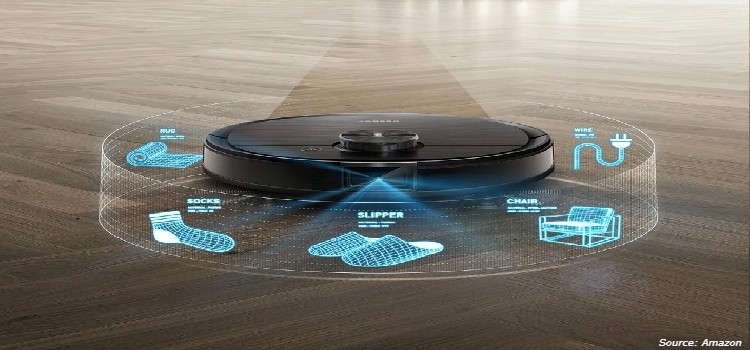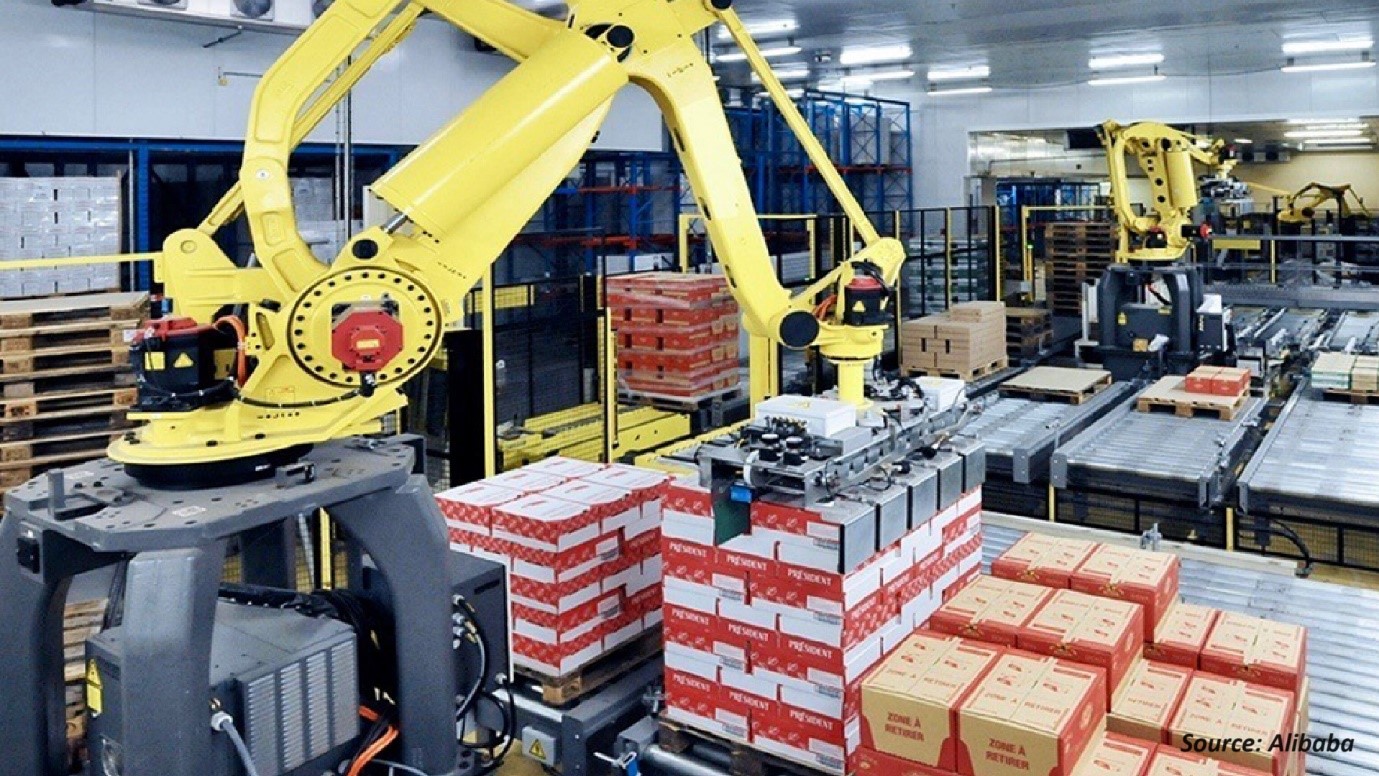
Mobile Robot Market by Product (Automated Guided Vehicle (AGV) and Autonomous Mobile Robot (AMR)), by Component (Hardware and Software), Type (Tow Vehicle, Tug Vehicle, Unit Load Vehicle, Pallet Truck, Forklift Vehicle, and Other Type), by Navigation Sensor (Laser/LiDar Guidance, Magnetic Guidance, Optical Tape Guidance, Vision Guidance, and Other Navigation Sensor), by Payload Capacity (100–250 kg, 250–500 kg, 500–1000 kg, 1000–1500 kg, 1500–2000 kg, and Above 2000 kg), and by End User (Semiconductor & Electronics, FMCGs, Automotive, Healthcare, Pharmaceutical, E-commerce, Logistics, Food & Beverage, and Other End User) – Global Opportunity Analysis and Industry Forecast, 2024–2030
Industry: ICT & Media | Publish Date: 23-Apr-2024 | No of Pages: 575 | No. of Tables: 452 | No. of Figures: 423 | Format: PDF | Report Code : N/A
Mobile Robot Market Overview:
The Mobile Robot Market size was valued at USD 6.83 billion in 2023 and is predicted to reach USD 14.31 billion by 2030, with a CAGR of 10.4% from 2024 to 2030. Moreover, the mobile robots market size was 377,468 units in 2023, and is predicted to reach 1,119,842 units in 2030, with a CAGR of 15.8% from 2024 to 2030.
The mobile robot industry is a dynamic sector incorporating two primary components: Autonomous Mobile Robots (AMRs) and Automated Guided Vehicles (AGVs). AMRs are sophisticated robotic systems designed to navigate and perform tasks autonomously in various environments without human intervention. They utilize a combination of sensors, artificial intelligence (AI), and advanced algorithms to perceive surroundings, make decisions, and execute actions independently.
AMRs use sensors such as LIDAR, RADAR, and ultrasonic sensors to collect information about their surroundings, enabling them to create detailed maps and navigate complex spaces. The onboard AI processes this data, generating navigation paths and control commands to perform tasks efficiently. AMRs, often recognized as simultaneous localization and mapping (SLAM) navigation robots, showcase effectiveness in material handling, inventory management, and collaborative interactions with humans.
AGVs, a subset of the mobile robot industry, follow predetermined paths or navigation systems within warehouses, distribution centers, or manufacturing facilities. They automate tasks such as material transportation and do not need any human intervention. Modern AGVs feature vision-guided sensors, enhancing collision avoidance and contributing to improved accuracy and adaptability, particularly in smart factory environments.
The combination of AMRs and AGVs defines the mobile robot industry, offering a spectrum of robotic solutions that autonomously navigate, adapt to surroundings, and perform various tasks. This industry plays a crucial role in increasing productivity & efficiency and implementing the Industry 4.0 principles, contributing to the evolution of smart factories.
Growing Emphasis on Automation and Industry 4.0 Drive the Industry
The mobile robot industry is experiencing a significant impact from the growing emphasis on automation and the Industry 4.0 principles. The increasing adoption of automation technologies, coupled with the principles of Industry 4.0, has become a driving force behind the evolution of mobile robots. Companies across various sectors recognize the need to streamline and optimize their operations through automated processes.
According to the 2022 McKinsey Global Industrial Robotics Survey, companies worldwide are investing substantially in robotics and automation. A significant proportion of these companies anticipate that automated systems will constitute nearly 25% of their capital spending in the next five years.
The rise of Industry 4.0 has led to a surge in the demand for mobile robots, as these machines align seamlessly with the objectives of creating smart and interconnected factories. The industry has witnessed advancements in robotics technology, enabling the development of sophisticated and versatile mobile robots capable of handling diverse tasks. This growing emphasis on automation and Industry 4.0 is a key driver influencing the trajectory and the mobile robot market growth.
Labor Shortage and Increasing Wages Fuel the Demand for Mobile Robots
The surge in demand for mobile robots is intricately linked to the prevailing challenges of labor shortages and rising wages. In an era where industries face a scarcity of skilled labor and the continuous upward trend in wage rates, businesses are increasingly turning to mobile robots as a strategic solution.
According to the Employment Cost Index (ECI), which tracks changes in the hourly labor cost to employers over time, the costs rose by 1.1% in the third quarter of 2023, following a 1.0% increase in the second quarter. Thus, mobile robots not only address the workforce crunch but also offer a cost-effective and efficient alternative for various tasks. The mutual relationship between the labor shortage and the rise in wages catalyzes the growing adoption of mobile robots across diverse sectors.
High Implementation and Integration Costs Hinder the Market Growth
The mobile robot industry faces challenges due to the high implementation and integration costs. Procuring and integrating mobile robotic systems into existing operations involve substantial upfront expenses, including robot acquisition, system integration, employee training, and infrastructure modifications. These financial barriers hinder widespread adoption, requiring solutions to promote broader implementation and effectively leverage the industry's benefits.
Expansion of Mobile Robots in the Semiconductor Industry Creates Opportunity
The expansion of mobile robots in the semiconductor industry presents a significant opportunity for technological advancements and operational efficiency. As the semiconductor sector demands precision, speed, and reliability in its processes, the integration of mobile robots helps address these requirements effectively. Mobile robots can be employed for tasks such as material handling, transportation of delicate components, and streamlining logistical operations within semiconductor facilities.
This expansion enhances the overall efficiency of semiconductor manufacturing and opens up avenues for innovation and optimization in a crucial industry that plays a pivotal role in various technological advancements. Companies such as KUKA AG, Omron Corporation, Castec International, and Murata Machinery have been actively developing and expanding mobile robots tailored to the semiconductor industry. They have been utilizing established components and advanced navigation systems to enhance performance and reliability.
Asia-Pacific Holds the Predominant Share in the Mobile Robot Market
The Asia-Pacific holds the major share in the mobile robot market, due to the factors such as the adoption of Industry 4.0 initiatives across the region. For example, Australia introduced an Industry 4.0 Taskforce, while India launched its Industry 4.0 Vision and Indonesia initiated Making Indonesia 4.0. These initiatives fuel the demand for robotics solutions, including AGVs and AMRs, as companies seek to optimize production capabilities and logistics operations.
Moreover, the increasing utilization of mobile robots, especially in the rapidly expanding e-commerce industry, propels the growth of the mobile robot industry. This is due to its essential role in optimizing warehouse, distribution, and manufacturing operations.
According to the estimates by Cello Square and eMarketer, leading countries in terms of retail e-commerce sales were dominated by Asian countries, with the Philippines and India recording growth of 24.1% and 22.3%, respectively, by the end of 2022.
In addition, prominent companies are introducing AMRs to streamline workflow across industries, propelling market growth. Recently, Omron launched a new MD-650 mobile robot, tailored for medium-duty material transfer tasks. This robot employs integrated control technology and a range of sensors, including LIDAR, RADAR, and ultrasonic sensors, for efficient autonomous navigation and detailed mapping in complex environments.
North America Estimated to Witness Significant Growth in the Market
North America is poised to witness significant growth during the forecast period, fueled by factors such as increased labor costs, the need for efficiency, and a labor shortage in e-commerce, logistics, and manufacturing industries. Statistics Canada reported a significant rise in unit labor costs across the country. The costs increased by 6.10% in just one year from Q3 2022 to Q3 2023.
Moreover, the presence of companies such as Fetch Robotics, OTTO Motors, and Clearpath Robotics, which employ product launches as a major strategy, is driving market growth. For instance, OTTO Motors launched the robust and agile OTTO 600 in March 2023, which is capable of handling payloads up to 600 kg.
In addition, the development of innovative mobile robots by prominent companies helps improve operational efficiency, driving the demand in the market. Recently, Amazon launched Sequoia, its latest mobile robot, in a Houston fulfillment center. This system combines various robots, improving delivery speed by 25%, while prioritizing workplace safety and efficiency. With 750,000 robots alongside employees, Amazon aims to enhance operational productivity and customer service.
Furthermore, the NRI-3.0 program supports fundamental research to advance robot integration science and enhance the use of robots for human benefits, emphasizing safety and independence. This initiative accelerates the development and adoption of advanced robotics technologies, including AMRs and AGVs, across diverse industries in the U.S.
Competitive Landscape
Various market players operating in the mobile robot industry include Geekplus Technology Co., Ltd., GreyOrange, Omron Corporation, Mobile Industrial Robots A/S, Locus Robotics, Toyota Industries Corporation, KION Group, JBT Corporation, Jungheinrich AG, ABB Ltd., Daifuku Co., Ltd., KUKA AG, Seegrid, E&K Automation, Murata Machinery Ltd., and others. These market players are adopting strategies such as collaboration and product launches across various regions to maintain their dominance in the market.
For instance, in September 2023, Omron introduced the MD-650 mobile robot, which is compliant with safety standards and aimed at streamlining material transport. In the dynamic autonomous mobile robot (AMR) market, Omron emphasizes advanced technologies such as artificial intelligence (AI) and machine learning (ML) to enhance efficiency and adaptability.
Also, in June 2023, Jungheinrich and Mitsubishi Logisnext launched Rocrich AGV Solutions, a joint venture expanding mobile automation in North America. The partnership combines Rocla and Jungheinrich's AGV portfolios, offering a comprehensive range of solutions. It reflects the growing demand for logistics automation in North America.
Moreover, in June 2023, Dematic, a subsidiary of KION Group, launched third-gen freezer-rated AGVs in Australia, featuring advanced sensor and navigation technology that exceed global safety standards. It is designed for freezer environments. These AGVs address challenges in cold storage facilities, showcasing Dematic's commitment to continuous improvement with cutting-edge technology.
In addition, in November 2022, GreyOrange partnered with SEKO Logistics to integrate GreyOrange's AI-powered Fulfilment Operating System and Ranger Mobile Sort robots. This integration will enhance logistics efficiency by optimizing order fulfillment processes and reducing human error.
Furthermore, in April 2021, Toyota Industries Corporation (TICO) launched T-Hive, a software for autonomous vehicles (AVs), including mobile robots and autonomous mobile robots. This development aims to unify control systems across TICO AVs, leveraging existing solutions to drive global innovations in response to the rising demand for logistics automation, especially in the Asia-Pacific region.
Mobile Robot Market Key Segments
By Product
-
Automated Guided Vehicle (AGV)
-
Autonomous Mobile Robot (AMR)
By Component
-
Hardware
-
Software
By Type
-
Tow Vehicle
-
Tug Vehicle
-
Unit Load Vehicle
-
Pallet Truck
-
Forklift Vehicle
-
Other Type
By Navigation Sensor
-
Laser/LiDar Guidance
-
Magnetic Guidance
-
Optical Tape Guidance
-
Vision Guidance
-
Other Navigation Sensor
By Payload Capacity
-
100–250 kg
-
250–500 kg
-
500–1000 kg
-
1000–1500 kg
-
1500–2000 kg
-
Above 2000 kg
By End User
-
Semiconductor & Electronics
-
FMCGs
-
Automotive
-
Healthcare
-
Pharmaceutical
-
E-commerce
-
Logistics
-
Food & Beverage
-
Other End User
By Region
-
North America
-
The U.S.
-
Canada
-
Mexico
-
-
Europe
-
The U.K.
-
Germany
-
France
-
Italy
-
Spain
-
Denmark
-
Netherlands
-
Finland
-
Sweden
-
Norway
-
Russia
-
Rest of Europe
-
- Asia-Pacific
-
China
-
Japan
-
India
-
Australia
-
South Korea
-
Taiwan
-
Singapore
-
Vietnam
-
Indonesia
-
Thailand
-
Rest of Asia-Pacific
-
-
Rest of World (RoW)
-
Latin America
-
Middle East
-
Africa
-
REPORT SCOPE AND SEGMENTATION:
|
Parameters |
Details |
|
Market Size in 2023 |
USD 6.83 Billion |
|
Revenue Forecast in 2030 |
USD 14.31 Billion |
|
Growth Rate |
CAGR of 10.4% from 2024 to 2030 |
|
Market Volumes in 2023 (units) |
377,468 |
|
Volumes Forecast in 2030 (units) |
1,119,842 |
|
Growth Rate |
CAGR of 15.8% from 2024 to 2030 |
|
Analysis Period |
2023–2030 |
|
Base Year Considered |
2023 |
|
Forecast Period |
2024–2030 |
|
Market Size Estimation |
Billion (USD)/ Units |
|
Growth Factors |
Growing Emphasis on Automation and the Industry 4.0 Labor Shortage and Increasing Wages |
|
Countries Covered |
29 |
|
Companies Profiled |
10 |
|
Market Share |
Available for 10 companies |
|
Customization Scope |
Free customization (equivalent to up to 80 working hours of analysts) after purchase. Addition or alteration to country, regional, and segment scope. |
|
Pricing and Purchase Options |
Avail customized purchase options to meet your exact research needs. |
Key Players
-
Geekplus Technology Co.Ltd.
-
GreyOrange
-
Omron Corporation
-
Mobile Industrial Robots A/S
-
Locus Robotics
-
Toyota Industries Corporation
-
KION Group
-
JBT Corporation
-
Jungheinrich AG
-
ABB Ltd.
-
Daifuku Co.Ltd.
-
KUKA AG
-
Seegrid
-
E&K Automation
-
Murata Machinery Ltd.




 Speak to Our Analyst
Speak to Our Analyst


































